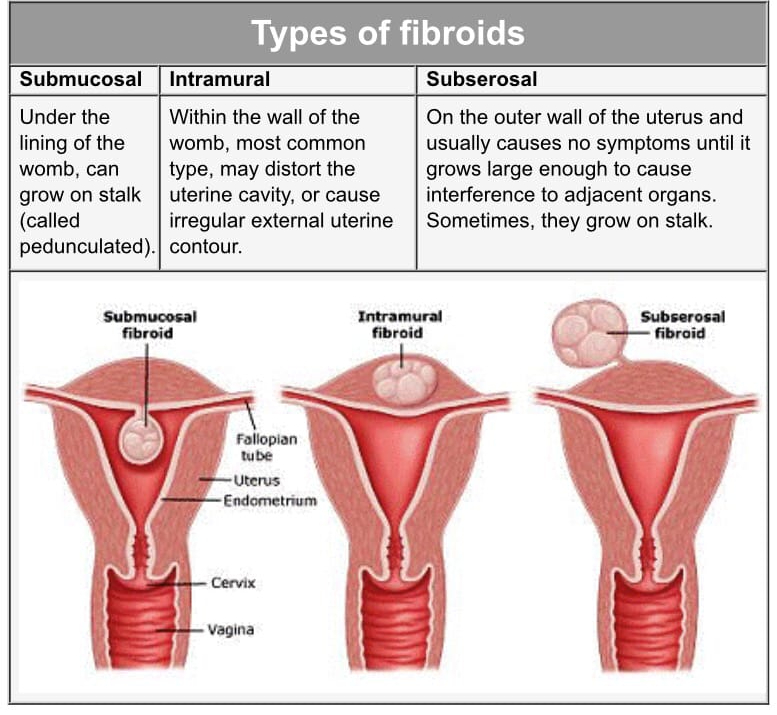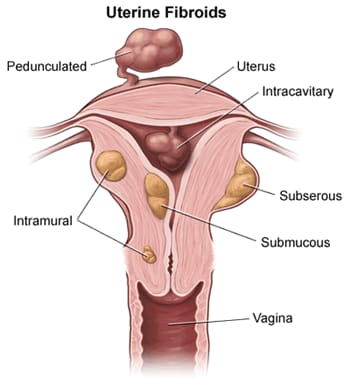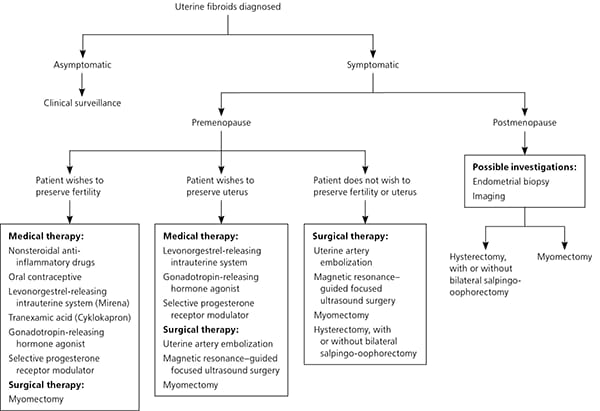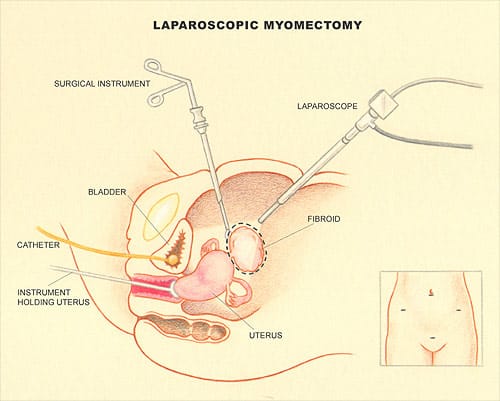Myomectomy
Myomectomy is the surgical removal of fibroids from the uterus. It allows the uterus to be left in place and, for some women, makes pregnancy more likely than before. Myomectomy is the preferred fibroid treatment for women who want to become pregnant.
Your doctor might recommend myomectomy for fibroids causing symptoms that are troublesome or interfere with your normal activities. If you need surgery, reasons to choose a myomectomy instead of a hysterectomy for uterine fibroids include: You plan to bear children
Treatment depends on severity. Treatments include medication and removal of the fibroid.


Treatments
1) Supportive care:
- Monitoring for changes or improvement
- Basic medication to control bleeding and pain relief
2) Devices:
- Progestin IUD ( Mirena, Emirelle)it is inserted in the uterus ( valid for 5 yrs )
3) Medications:
- Birth control ( low dose OC pills 21 days )
- Hormones ( Mifepristone 10/25 mg , Ulipristal acetate 5 mg
- Sex hormone suppression(Leupride Depot 3.75 mg IM)
- It is followed with repeat sonography after the treatment is complete
4) Surgery :
- Conservative surgery : Open / Laparoscopic / Hysteroscopic
- Hysterectomy
5) Medical procedure :
- Ablation, Uterine artery embolization and Endometrial ablation

What you can expect?
Depending on the size, number and location of your fibroids, your surgeon may choose one of three surgical approaches to myomectomy.
- Preoperative work up
- Thorough pelvic examination
- Routine Blood investigations
- Ultrasound pelvis
- Hospital stay is approx 2 to 4 days

Types Of Myomectomy
Abdominal Myomectomy :
In abdominal myomectomy (laparotomy), your surgeon makes an open abdominal incision to access your uterus and remove fibroids. Your surgeon will generally prefer to make a low, horizontal ("bikini line") incision, if possible. Vertical incisions are needed for larger uteruses.

Laparoscopic or Robotic Myomectomy :
In laparoscopic or robotic myomectomy, both minimally invasive procedures, your surgeon accesses and removes fibroids through several small abdominal incisions.
Compared with women who have a laparotomy, women who undergo laparoscopy have less blood loss, shorter hospital stays and recovery, and lower rates of complications and adhesion formation after surgery. There are limited comparisons between laparoscopic and robotic myomectomy. Robotic surgery may take longer and be more costly, but otherwise few differences in outcomes are reported.
Laparoscopic Myomectomy :
Your surgeon makes a small incision in or near your bellybutton. Then he or she inserts a laparoscope — a narrow tube fitted with a camera — into your abdomen. Your surgeon performs the surgery with instruments inserted through other small incisions in your abdominal wall.

Robotic Myomectomy:
Your surgeon inserts instruments through small incisions similar to those in a laparoscopic myomectomy, and then controls movement of the instruments from a separate console. Some surgeons are now performing single-port (one incision) laparoscopic and robotic myomectomies.
Risk & Recovery
Risks of Myomectomy include:
- Excessive blood loss. ...
- Scar tissue. ...
- Pregnancy or childbirth complications. ...
- Rare chance of hysterectomy. ...
- Rare chance of spreading a cancerous tumor.
Hysterectomy is reserved for women who have completed family or are not not benefitted by oral treatment or do not wish for conservative treatment
Your Recovery :
You can expect to feel better and stronger each day, although you may tire quickly and need pain medicine for a week or two. You may need about 4 to 6 weeks to fully recover. Do not lift anything heavy while you are recovering so that your incision and your belly muscles can heal.
Yearly follow up with ultrasound is required as some women may have a tendency to develop fibroids .
Child bearing can be attempted as per individual case on doctor's advice.
OPD Timings
Dr. Mandar R Gadgil
| Mon – Fri | - | 4:30 PM - 7:30 PM w.e.f. 27th August 2022 |
| Saturday | - | 10:00 AM - 11:30 AM |
OPD Timings
Dr. Maithilee Gadgil
| MON – SAT | - | 10:00 AM - 12:30 PM |
| MON – FRI | - | 4:30 PM - 07:00 PM w.e.f. 27th August 2022 |
Any Question Or Query
Feel free to ask for your any Question or Query /
Book An Appointment
Appointment
To book appointment call us on

